We Designed the Perfect Electric Adventure Vehicle
This article originally appeared on Outside
Why don't you own an electric vehicle? For adventurous types like you and me, that's a fair question. Doing stuff outdoors means we care about the environment, right? So, with electric adventure vehicles now hitting the market, why aren't we ditching our inefficient internal combustion engine 4x4s? The answer is simple: EV trucks and SUVs just aren't practical yet. But in a dream scenario, here's what I think an efficient, badass EV adventuremobile might look like.
The problem with current electric off-roaders like the Rivian R1T and GMC Hummer EV is that they chase extremes. Clocking in at around three seconds from zero to 60 miles per hour, they're extremely fast. They also carry enormous battery packs, making them extremely heavy. Bringing an extremely fast, extremely heavy vehicle to market before anyone else is extremely expensive. And extremes just don't equal practicality.
Take these vehicles' ranges, for example. The EPA range for the Hummer is 329 miles. The current version of the R1T comes in at 314. That might sound workable if all you're doing with your electric megatruck is driving it from your beach house in Malibu to a soundstage in Hollywood. But what if you want to take that vehicle on a camping trip? The rule of thumb when estimating the range of any vehicle is to cut the official number in half the second your wheels touch dirt. So, 314 miles becomes 157 on forest service roads. And you have to get to and from your destination within that range, so all of a sudden you're restricted to locations no more than 78 miles from a charging station if you want to plan a risk-free trip. That number decreases again if you need to tackle challenging terrain, haul a bunch of weight, or face cold weather. I don't know about you, but there are lots of places I want to go camping that are more than 78 miles from the nearest town.
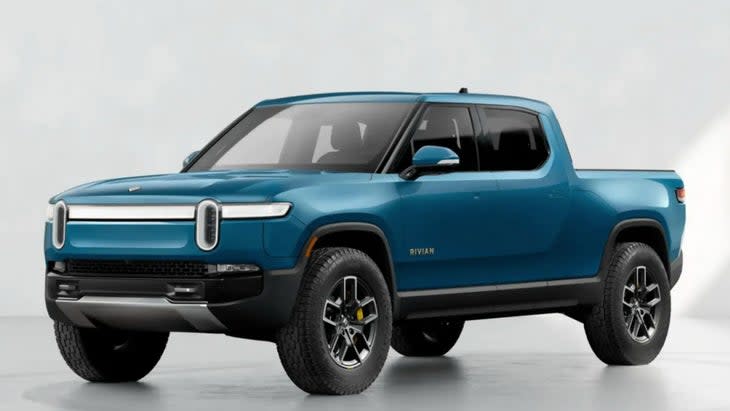
The R1T and Hummer EV don't just limit your camping trips to 78 miles because that's the limit of the available technology. They limit your camping trips to 78 miles because they're not designed to go camping. They're designed to make headlines. It seems both automakers decided that the way to sell a huge volume of electric trucks, sometime in the future, is to win over a small number of tastemakers, celebrities, and tech bros now. And if the set of people who can afford to drop six-figure sums on impractical vehicles have one thing in common, it's speed. Specifically, a need for it.
So, the R1T makes 835 horsepower and 908 pound-feet of torque using an ultracomplicated, torque-vectoring four-motor setup. The Hummer EV uses one motor on each rear wheel and a single motor on the front axle to deliver 1,000 horsepower. GMC is currently exaggerating the amount of torque those motors make, but it's probably safe to bet it's at least as much as the Rivian. And providing juice for all those motors and all that power isn't easy. The Rivian's battery pack holds 135 kilowatt-hours; the Hummer's measures a full 200. Batteries are heavy and expensive. As a result, the Rivian weighs 7,173 pounds and starts at $85,000; the Hummer comes in at a positively ridiculous 9,063 pounds and $112,595. Bottom line: moving all that weight with all that power will never be an efficient endeavor. Upcoming EV trucks from Ford and Chevy are better but not by much.
And the problems with existing and near-future EVs continue. Let's sum them up in a list.
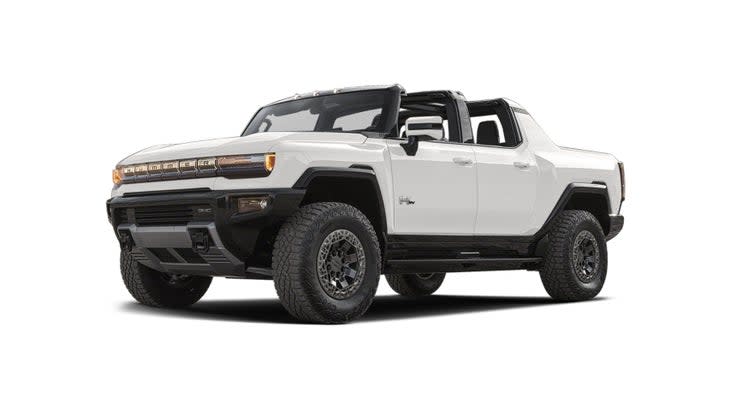
The Problems with EV Trucks
Extreme complication equals a nearly endless list of potential failure points. And anything that can break will break off-road.
Size, weight, and power all make driving off-road more challenging and more dangerous.
Weight is the enemy of efficiency. Every pound you add increases the size, strength, and cost of every component in the vehicle; requires more energy to move; and will cause consumable components like tires to wear out faster, increasing the vehicle’s environmental footprint.
Multiple motors can't yet deliver true wheel-speed matching, limiting traction off-road.
Limited range and practicality means existing EV trucks can't fulfill all the vehicle needs within a normal household; owning one requires also owning at least one other vehicle.
When it comes to tires, you can only have two of three possible features: low rolling resistance, the ability to put down huge power on pavement, or off-road traction.
They all try to solve problems beyond simply going electric. Ski tunnels, rear-wheel steering, pivoting in place, induction kitchens, variable-height suspension, the ability to power a home, and other whizz-bang stuff is neat and all, but it comes at the expense of cost, weight, complication, and mission creep.
To date, all fail to take advantage of the packaging efficiencies made possible by ditching the fixed mechanical layout of internal combustion engine (ICE) powertrains.
The Solution
I propose a vehicle that takes the opposite approach to any of the above. A compact, efficient, affordable electric pickup truck equipped with true four-wheel drive and attempting little else beyond taking advantage of the innate benefits an electric powertrain provides.
Why a Pickup?
Pickups are the bestselling vehicles in this country for a reason. While they're typically longer and more ungainly than equivalent SUVs, the bed offers more versatility. No other vehicle is able to make dump runs, bring home a load of lumber, comfortably haul passengers, and operate off-road with the all-around alacrity of a pickup.
For our practical electric pickup truck to be truly efficient, it needs to be able to replace any other vehicles in an owner's garage. It's not just a low purchase price that makes a vehicle affordable for most, but its ability to perform most tasks in most conditions. Producing vehicles, no matter their power source, also comes with its own environmental footprint, often one that’s equivalent to multiple years of driving a gas-powered vehicle. So our goal here needs to be replacing the need to own an ICE vehicle altogether, not just adding one more truck to your collection.
That includes operating as an adventuremobile. The same pickup I use to drive my dogs to local trailheads is the same pickup I use to go hunting, fishing, skiing, and camping. That same pickup transported those dogs and my now-wife to our wedding in Baja Sur. That same pickup takes us to our cabin in Glacier National Park every Christmas. I'll drive that same pickup to the grocery store after I finish this article. I just wish that pickup would harm the environment less.
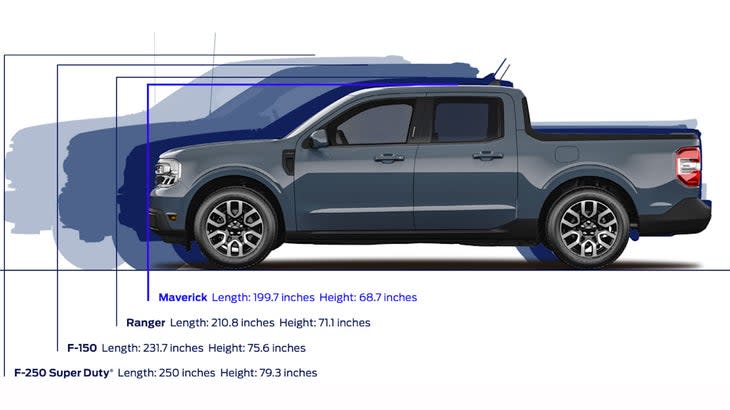
Compact Size
Perhaps the most paradigm-shifting truck of 2021 wasn't the R1T or Hummer EV, but rather the humble Ford Maverick. Starting at just $20,000, it combines affordability with compact dimensions. And it's been a runaway success. Since the Maverick was revealed in October, customers have placed more than 100,000 orders for it. So many, in fact, that Ford has had to stop accepting new deposits.
Starting with compact dimensions similar to those of the Maverick makes sense since the key to making our practical electric adventuremobile work is to prioritize efficiency at every level. Smaller vehicles are cheaper to produce, easier to drive, and require less energy to move.
But the Maverick is a unibody crossover--a vehicle that's built like a car but looks like a truck. And ultimately that lightweight construction and the lack of traction inherent in any all-wheel drive system will massively limit its ability off-road. I want to create a real adventuremobile here, one that can go where any other 4×4 can, so our practical electric pickup needs to be a body-on-frame design, with a bed mounted separately from the cab, to allow the two to flex independently when carrying weight off-road.
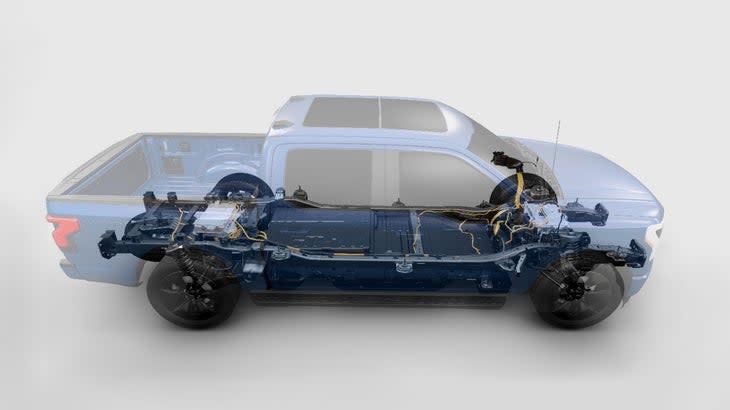
Two-Box Design
The Maverick's other big problem is that it looks like a normal three-box pickup. In car design, a "box" is any major area of a vehicle delineated by a large change in height when viewed from the side. Picture a normal pickup truck: there's a low box for the front third, where the internal combustion engine normally goes; a tall middle box for humans and dogs; then a low rear box for the bed. This may help the Maverick appeal to consumers with a preference for traditional looks, but it massively limits space. And I want our truck to sell on the merits of its practicality, not its looks.
Since electric motors are very small and don't need to be bolted to a large transmission or require big radiators, they free EVs from traditional packaging constraints. Looking at a side-on photo of the Maverick, you can see that its hood eats up nearly as much length as its 4.5-foot cargo bed. Once again capitalizing on efficiency, shifting the cab forward could add room for passengers while making space for a substantially longer bed without adding to the vehicle's 200-inch length.
I'd target at least a six-foot bed length and dispense with any frivolous secondary storage areas, like a frunk. Truck users need space in the bed first and foremost. Sacrificing bed space by building in storage elsewhere reduces practicality and versatility.
One thing I'm not proposing here is a cab-over or forward-control-style arrangement. Those outdated designs prioritize space to such an extreme that they leave no room for a front crumple zone. What I'm envisioning would look more like a traditional van front end, where the occupants still sit behind the front axle, if substantially further forward than in a traditional three-box pickup. That should leave plenty of room for an energy-absorbing crash structure in front of the passenger compartment and front axle, while also leaving open the potential to reduce the Maverick's front and rear overhangs a bit in order to improve our practical electric pickup's approach and departure angles. The just-announced Volkswagen ID Buzz electric van takes a similar approach.
Single Motor, 4WD
Our practical electric pickup truck won't hit 60 miles per hour in under three seconds. But unlike the faster competition, it will be able to climb a steep slope without spinning wheels and pivoting sideways. Why? I plan to ditch the complicated multi-motor convention for a single electric motor driving the wheels through a conventional 4WD transfer case, front and rear driveshafts, and locking axle diffs.
You see, the problem with multiple motors is that it's not yet possible to control them to a fine enough degree to totally match the speeds of wheels they control. It's wheel-speed matching, not power apportionment, by which we measure the potential for off-road traction. Four-wheel drive matches the speeds of the front and rear axles, then locking differentials lock the speeds of wheels across those axles.
David Tracy does a great job of explaining why multiple electric motors aren't great at off-road traction and the problems that causes in his review of the R1T. Scott Brady found the same issue with the Hummer EV.
Fortunately, a centrally mounted electric motor has no problem driving a traditional transfer case. This is the arrangement used by the new Toyota Tundra hybrid when it's operating in electric-only mode. And once power enters the transfer case, the drive shafts, diffs, and axles won't know what source created it.
Would a single motor produce enough performance? Look at the upcoming F-150 Lightning, which uses a single motor on each axle to produce a combined 426 horsepower and 775 pound-feet of torque in standard range configuration. Assuming both those motors are the same, a single one of them would produce 213 horsepower and 387 pound-feet of torque. That's 122 pound-feet more torque than is produced by the the ICE F-150's base 3.3-liter V6.
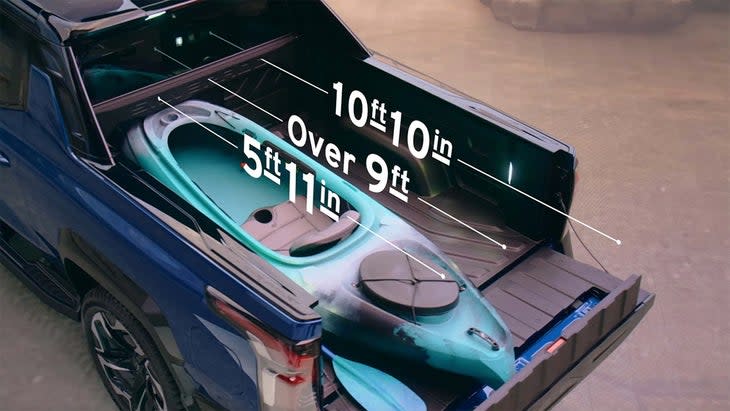
Capability Without Inefficiency
Producing a smaller, lighter, simpler electric pickup truck creates a cascading list of efficiencies. That single-motor four-wheel drive setup is a perfect example. Not only is it simple, proven, and durable, but by nominally operating the vehicle in two-wheel drive, as you would on the street, you free the motor of the need to power the front driveshaft and axle, reducing drag and improving efficiency.
And efficiency can be extended off-road without reducing capability. For example, by employing a rear diff that could remain locked at any speed, you could retain good-enough traction for most dirt road driving while still operating the vehicle in 2WD.
Another easy victory comes from tires. Crazy-powerful electric trucks have to run crazy-wide street tires to transfer that power to the road. By sticking to a sensible performance level, our practical truck could get away with a much narrower tire while running a genuine all-terrain. Narrower tires actually provide better traction on off-road surfaces, require less energy to accelerate and decelerate, and create less wind resistance at higher speeds. Which is to say they'd waste less power everywhere. And that inherent efficiency would allow us to equip the vehicle with a relatively tall tire, boosting its ability to tackle large obstacles in stock form. I'm thinking of something like a 255/80-17 Toyo Open Country ATIII, which measures 33.1 inches tall and just 10 inches wide.
Sticking with a wheelbase similar to that of the Ford Maverick--121 inches--and running 33-inch tires would endow our practical electric pickup truck with better approach, departure, and breakover angles and more ground clearance than any midsize ICE truck, all in a package with more interior room and even a larger bed. That right there would make our truck a more compelling purchase than rival ICE vehicles even before you factored in its green credentials.
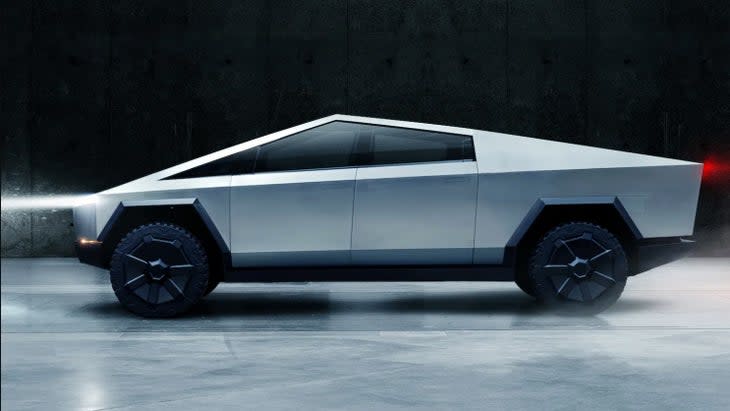
Easy Personalization
Another reason I want to make this practical electric adventuremobile a pickup is that the open bed makes an easy canvas for customization. Want to carry mountain bikes without taking the wheels off? You can. Want to bring home some furniture or a yard of mulch? You can do that, too. And the possibilities keep going. I'm thinking, of course, about adding an ultralight wedge camper like the GoFastCampers Platform. That alone would transform our practical electric pickup into a practical electric overland vehicle in one fell swoop.
Setting up a vehicle so it can be easily modified requires a little forethought but creates endless possibilities. Removable bumpers made from simple black ABS plastic would protect the vehicle from light off-road and parking lot scrapes in stock form and could easily be replaced with aftermarket steel or aluminum items that would increase protection and add the ability to mount a winch and driving lights.
Sticking with the suspension hard points, configuration, and components from an existing midsize ICE truck would open that vehicle's entire aftermarket suspension catalog to practical EV pickup owners from day one.
And while it's impossible or impractical to carry solar panels large enough to meaningfully recharge an EV pickup's large battery, providing inputs for panels and the ability to draw small amounts of power to run camp gadgets like lights and fridges would enable owners to enjoy camping more, without worrying about reducing their ultimate range or carrying an auxiliary battery pack.
Buyers would view all of these potential capabilities as significant value, all with very little actual investment from the automaker. Low prices, more use cases--everyone wins.

What About Range?
The golden question. The whole idea here is to make a truck that's as efficient as possible, enabling it to achieve the longest range with the smallest battery pack. Getting the ratio of efficiency to capacity right is complicated and will involve factors we haven't discussed here. Erring in the direction of efficiency over capacity will also be a major determining factor when it comes to purchase price.
Given the general unavailability of charging stations in rural areas and the inability to easily carry extra electricity, the EPA range it would take to get me into an EV would be 600 miles. That would make on-road travel through wide-open parts of the American West stress-free and, with careful planning, would even open up places like Baja to camping trips.
It's my hope that taking advantage of the compound efficiencies discussed here would help boost off-road range, at least over easy dirt roads, to something greater than half of the EPA estimate. But even using that rule of thumb as a worst-case scenario, 300 miles is a lot of distance off-road. Do I commonly travel that far on camping trips? Not all in one go, but that would be enough range to reduce my anxiety about traveling through remote places in a single vehicle. When doing that in my ICE truck, I always try to carry enough extra gas so that I can afford to make an error in navigation, enjoy a quick side trip somewhere interesting, and make it so an unexpectedly closed gas station doesn't spell disaster. A 600-mile EPA range feels safe within those calculations.
That 600-mile range would also be enough that I wouldn't have to own a second vehicle just to take long trips.
What would it take to get there? Let's look again at that Ford F-150 Lightning, which, when it goes on sale this spring, will be the closest thing to a practical electric pickup. In Extended Range form, it returns a 300-mile EPA range from a 131-kilowatt-hour battery pack that, on its own, weighs 2,050 pounds. That version of the truck will start at $55,000. Currently, EV batteries cost about $132 per kilowatt-hour.
It's unlikely that running a single motor in a smaller, lighter, simpler truck would be enough to double that range. But simply adding a 131-kilowatt-hour battery to a Ford Maverick, without doing anything else described here, would come close to doubling its weight and price. We'd basically just be recreating the problems of extreme weight and cost, albeit in a slower package.
So, why aren't we all driving practical electric pickup trucks? I fear the reason is that they simply aren't possible. Yet.
For exclusive access to all of our fitness, gear, adventure, and travel stories, plus discounts on trips, events, and gear, sign up for Outside+ today.

